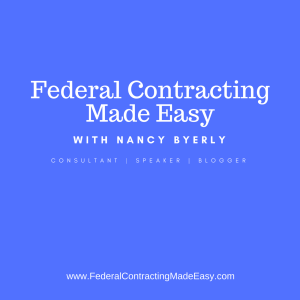
Federal Contracting Made Easy's podcast
Business & Economics Podcasts
Do you want to bid on government contracts but don’t know where to start? Are you presently a federal contractor but have questions that no one seems to know the answer too? If so, then Federal Contracting Made Easy is for you. Listen in and learn: How to find Federal Agencies that use your products or services, or how to find opportunities before they are placed on Fed Biz Ops. Obtain Knowledge Fast, Learn at your pace. Our 20-minute podcasts are aimed to give you the information that you need and nothing more. Nancy Byerly of FederalContractingMadeEasy.com reveals all her federal contracting strategies so that you can be ahead of the curve.
Location:
United States
Description:
Do you want to bid on government contracts but don’t know where to start? Are you presently a federal contractor but have questions that no one seems to know the answer too? If so, then Federal Contracting Made Easy is for you. Listen in and learn: How to find Federal Agencies that use your products or services, or how to find opportunities before they are placed on Fed Biz Ops. Obtain Knowledge Fast, Learn at your pace. Our 20-minute podcasts are aimed to give you the information that you need and nothing more. Nancy Byerly of FederalContractingMadeEasy.com reveals all her federal contracting strategies so that you can be ahead of the curve.
Language:
English
All About Teaming Agreements
Duration:00:18:22
Steps To Become A Government Contractor
Duration:00:17:41
Contracting Trends - Woman Owned Small Business
Duration:00:10:34
Service Disabled Veteran-Owned Small Business - A Decade of Trends
Duration:00:10:03
HUBZone Contracting Dollars DOWN 71% Since 2010
Duration:00:12:07
Is SBA's 8(a) BD Program Dying?
Duration:00:07:44
Trends in Contracting Affecting Small Business
Duration:00:12:45
Changes To HUBZone Program
Duration:00:09:15
Top 6 Mistakes New Government Contractors Make
Duration:00:11:35
Small Business Size Standards
Duration:00:11:39
2019 Small Business Economic Update
Duration:00:10:36
DBE Program - Interview with Raymond Christy with SLC Airports
Duration:00:32:19
What is the DBE Program?
Duration:00:15:50
Government Contract Disputes & Claims
Duration:00:09:51
How To File a Government Accountability Office (GAO) Protest?
Duration:00:26:05
How To File An Agency Protest?
Duration:00:09:53
8(a) Protests & More Plus GiveAway
Duration:00:17:12
All About Protests Pt 2 PLUS GiveAway
Duration:00:16:48
All About Protests, Part One
Duration:00:11:32
Breach of Contract
Duration:00:04:22